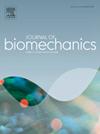确定计算不同速度跑步过程中关节协调性及其变化的最佳周期数:时间序列分析。
IF 2.4
3区 医学
Q3 BIOPHYSICS
引用次数: 0
摘要
了解跑步过程中人类运动协调性和可变性的复杂性,对于揭示运动动态、确定潜在的损伤机制和了解技能发展至关重要。确定计算可靠的协调性及其变异性所需的最少循环次数,有助于更好地组织测试和有效利用评估时间。本研究采用横断面研究设计,使用连续相对相位(CRP)方法调查了计算髋-膝、髋-踝和膝-踝协调性所需的最小循环次数及其变异性。29 名健康成年人在跑步机上以 9、12.5 和 16 km.h-1 的速度跑步,同时使用 6 台光电摄像机记录他们下肢的三维运动学数据。通过类内相关系数(ICC)分析,评估了每种速度下不同步态周期(3、5、10、20、30)中 CRP 及其变异性(CRPv)之间的可靠性。计算所有速度的 CRP 至少需要 10 个循环,而 CRPv 至少需要 30 个循环才能获得中等至良好的可靠性。虽然增加循环次数可改善关节间 CRP 的 ICC 值,但 CRPv 并未持续观察到相同的趋势,这强调了单独评估 CRP 及其变异性指标的重要性。本文章由计算机程序翻译,如有差异,请以英文原文为准。
Determining the optimum number of cycles for calculating joint coordination and its variability during running at different speeds: A timeseries analysis
Understanding the intricacies of human movement coordination and variability during running is crucial to unraveling the dynamics of locomotion, identifying potential injury mechanisms and understanding skill development. Identification of minimum number of cycles for calculation of reliable coordination and its variability could help with better test organization and efficient assessment time. By adopting a cross-sectional study design, this study investigated the minimum required cycles for calculating hip-knee, hip-ankle and knee-ankle coordination and their variability using a continuous relative phase (CRP) method. Twenty-nine healthy adults ran on a treadmill at speeds of 9, 12.5, and 16 km.h−1 while 3D kinematic data of their lower limbs were recorded using 6 optoelectronic cameras. Using Intraclass Correlation Coefficient (ICC) analysis, reliability between CRP and its variability (CRPv) in different gait cycles (3, 5, 10, 20, 30) was assessed for each speed. A minimum of 10 cycles was required for CRP calculation across all speeds, whereas CRPv necessitated a minimum of 30 cycles for moderate to good reliability. While increasing the number of cycles improved ICC values for inter-joint CRP, the same trend was not consistently observed for CRPv, emphasizing the importance of separately assessing CRP and its variability metrics.
求助全文
通过发布文献求助,成功后即可免费获取论文全文。
去求助
来源期刊

Journal of biomechanics
生物-工程:生物医学
CiteScore
5.10
自引率
4.20%
发文量
345
审稿时长
1 months
期刊介绍:
The Journal of Biomechanics publishes reports of original and substantial findings using the principles of mechanics to explore biological problems. Analytical, as well as experimental papers may be submitted, and the journal accepts original articles, surveys and perspective articles (usually by Editorial invitation only), book reviews and letters to the Editor. The criteria for acceptance of manuscripts include excellence, novelty, significance, clarity, conciseness and interest to the readership.
Papers published in the journal may cover a wide range of topics in biomechanics, including, but not limited to:
-Fundamental Topics - Biomechanics of the musculoskeletal, cardiovascular, and respiratory systems, mechanics of hard and soft tissues, biofluid mechanics, mechanics of prostheses and implant-tissue interfaces, mechanics of cells.
-Cardiovascular and Respiratory Biomechanics - Mechanics of blood-flow, air-flow, mechanics of the soft tissues, flow-tissue or flow-prosthesis interactions.
-Cell Biomechanics - Biomechanic analyses of cells, membranes and sub-cellular structures; the relationship of the mechanical environment to cell and tissue response.
-Dental Biomechanics - Design and analysis of dental tissues and prostheses, mechanics of chewing.
-Functional Tissue Engineering - The role of biomechanical factors in engineered tissue replacements and regenerative medicine.
-Injury Biomechanics - Mechanics of impact and trauma, dynamics of man-machine interaction.
-Molecular Biomechanics - Mechanical analyses of biomolecules.
-Orthopedic Biomechanics - Mechanics of fracture and fracture fixation, mechanics of implants and implant fixation, mechanics of bones and joints, wear of natural and artificial joints.
-Rehabilitation Biomechanics - Analyses of gait, mechanics of prosthetics and orthotics.
-Sports Biomechanics - Mechanical analyses of sports performance.
 求助内容:
求助内容: 应助结果提醒方式:
应助结果提醒方式:


